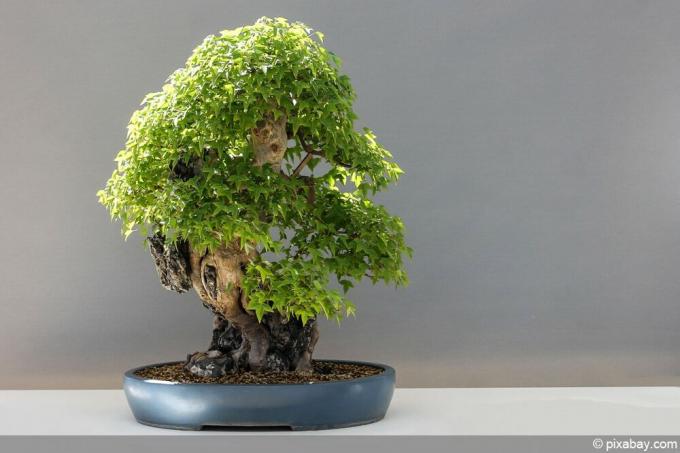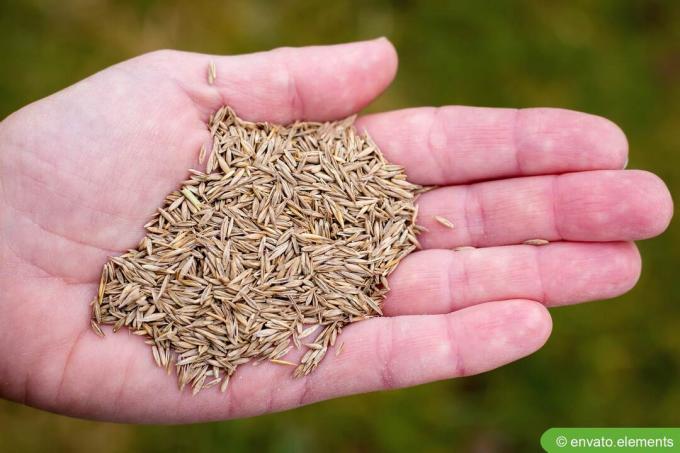

Table of contents
- background
- seed
- Accesories
- Growing tips
- The right time
- Install drainage layer
- Distribute seed material, leaving gaps
- Press the cover soil carefully
- Always keep the plant substrate slightly moist
- Choose a bright, warm location
- planting
- root canal treatment
Most bonsai lovers buy the objects of their desire as ready-made trees. They may also get young plants to be able to observe the growth process. Very few, however, grow plants from seeds. It makes sense to accompany the tree from germination to planting to full development. The cultivation itself is easy, but requires a lot of patience.
background
Bonsai trees are small works of art that cannot be found in nature. Rather, they are man-made. behaved. In most cases, this happens under the influence of violence. Branches are wired, tied or even cut off. On the other hand, it is much easier and gentler to grow the trees yourself. What is meant by this is the cultivation from seeds. In this way, the later form can be influenced at a very early stage. The problem with this: It takes a very long time to get to a tree. On average, it takes around three years for the tree plant to reach a size worth mentioning. Patience is therefore essential when growing from seed.
seed
Bonsai trees are not a separate genus or species. As already mentioned, nature does not know the characteristic, short stature. Consequently, there are no explicit bonsai seeds that can be purchased in specialist shops. Instead, you have to get tree seeds, which are best collected directly outside in nature. Chestnuts, acorns or even pine cones are suitable for this. In principle, almost any tree species can be used. Chestnuts, acorns or pine cones, however, are much easier to recognize and therefore to find than many other tree species. Incidentally, specialized shops now offer various seed packets for sale, from which the respective tree species can then be used. Depending on the species, the seed material must be specially prepared for germination to succeed.
Accesories
Of course, growing bonsai not only requires seeds, but also various accessories, without which the process would not even be possible. This necessarily includes:
- seed tray
- growing soil or Standard bonsai soil
- drainage material
- transparent plastic film
- alternatively: small indoor greenhouse

The use of a plant lamp can also be helpful. As a rule, however, this is not necessary if a continuously bright location is available for the planting bowl.
Growing tips
It is a really long way to the finished bonsai tree. And of course it's no fun if you fail to grow the plants. However, germinating tree seeds is not rocket science either. Here are a few important tips:
The right time
Tree seeds should always be sown in autumn. In this way one follows the natural course of nature. Usually the seed material will start to germinate in early spring. The resulting seedling then has a whole summer to grow and become stronger. This creates the best conditions for a healthy tree.
Install drainage layer
The tree seed is sown in a planter. Bonsai soil from specialist shops is perfect as a plant substrate. However, a drainage layer should be installed under the substrate so that the irrigation water can drain off easily. Moisture is of great importance for germination success, but wetness tends to be counterproductive. The following are suitable as drainage material:
- all coarse-grained substrates
- lava rock
- potsherds
- gravel
- stones of different sizes
The drainage layer should have an even thickness of at least two centimeters and cover the entire cultivation tray. Of course, it is also important in this context that the bowl has drainage openings in the bottom.
Distribute seed material, leaving gaps
The seed material is loosely distributed over the entire plant substrate. It is not necessary to press the individual grains into the soil. However, it is important to ensure that there is a certain distance between the individual grains so that the seedlings do not get in each other's way later. One to two centimeters are sufficient. Incidentally, the seeds are then covered with a layer of standard bonsai soil about one centimeter thick.
Press the cover soil carefully
The top layer over the seeds should be distributed as evenly as possible. It is important that you put them on or off carefully. is pressed. However, one should proceed rather gently. The soil should be firm but not hard
Always keep the plant substrate slightly moist
Once the thick layer has been pressed on, it is poured on immediately. The following applies to the further course of the cultivation phase: always keep the substrate slightly moist.
Choose a bright, warm location
Heat and light are the most important factors for a seed to germinate. As a result, the brightest possible location for the planter is mandatory. In addition, there should also be a constant temperature at the location. A temperature of around 20 degrees Celsius is usually sufficient. If you want to be on the safe side, you can cover the entire bowl with a transparent plastic film, creating a greenhouse atmosphere. However, the foil must contain a few holes. Alternatively, the use of a room greenhouse is also possible.
planting

If the seedlings or When young plants are a few centimeters tall, you can start transplanting them into a larger container. You have to be very careful when doing this.
Basically:
Transplant bonsai as little as possible.
When digging up the seedling, care should be taken not to damage the roots or the rest of the plant. It is best to first remove the soil in the root area carefully and very gently with a small spoon or a wooden spatula. In the new vessel, a small depression is then created in the substrate, into which the roots are then embedded. The area around the trunk is then carefully pressed and immediately cast on well.
root canal treatment
Even at this very early stage you can influence the later growth of the tree. To do this, the roots must be pruned. After removal from the seed tray, the fine root system is carefully removed from the soil. Already dried or very wet root parts are then simply cut off with disinfected scissors.
 garden editorial
garden editorial I write about everything that interests me in my garden.
Learn more about seeds

Light germinators or dark germinators? | differences and examples
While some seeds need light to germinate, others ripen in the dark. Based on the required light spectrum, plants are divided into different types of germs, into light, dark and light-neutral germs. At the latest when the seed does not sprout despite good care, the differences become clear.

Bamboo Seeds: Harvest and grow new plants from seed
The bamboo, which sometimes grows over ten meters high, is enjoying growing popularity in gardens or in containers. Due to the extremely rare flower, propagation using self-collected seeds is difficult, but the giant grass can be reproduced very well by division.

Just sprinkle lawn seed: is that enough?
At some point, every lawn will have one or two bare spots, which you can best close with quick overseeding. Read why simply sprinkling the lawn seed is often not such a good idea.

Propagating canna from seeds: how it's done
Growing cannas from seeds is more difficult and requires more money than dividing their roots. With a few tricks, however, propagation is also possible in this way and can be a new challenge for passionate flower lovers.

Grow peppers yourself from seeds: instructions
Growing peppers yourself is easy, because the popular vegetable can easily be propagated from seeds. In this article you will find out how the sowing works best.

Grow pampas grass from seeds: we explain how
Pampas grass is considered easy to cultivate and can be successfully propagated by breeding. Under controlled conditions in the planter, the germination success is higher than with direct outdoor sowing. The procedures regarding substrate, choice of location and care hardly differ in these variants.



